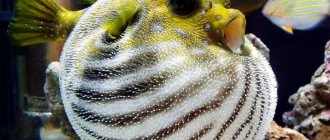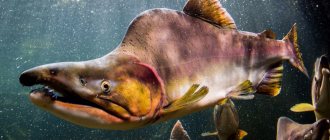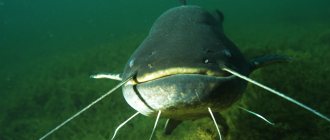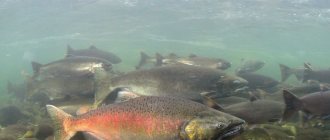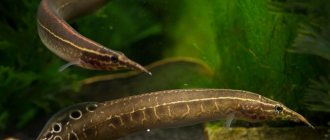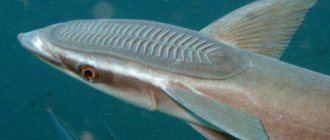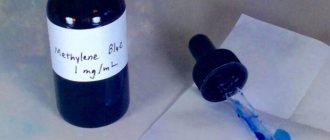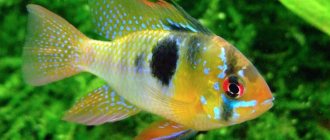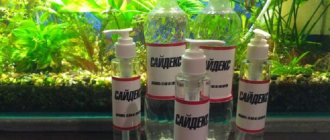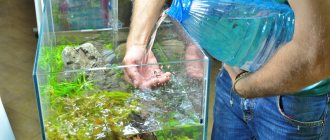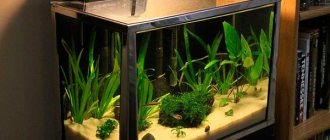This is one of the oldest representatives of the underwater world on our planet. It has several names - pantodon, butterfly fish, and some aquarists call it moth fish. In the wild, Pantodon Buchholzi live in stagnant freshwater bodies of water or shallow, calmly flowing tropical rivers. This is a predator whose impeccable hunting tactics have been perfected over thousands of years.
For breeding in an aquarium, fish are quite whimsical and require special conditions.
Habitat in nature
The main distribution area is freshwater rivers and lakes of the western and central parts of the African continent. Due to their special hunting method, they inhabit swampy, mostly shallow water bodies overgrown with vegetation. They track prey, hiding in the shade of algae or leaves of aquatic plants, near the surface of the water.
Lifestyle
This is the oldest species, which appeared more than a hundred million years ago. The process of evolution has not affected these amazing underwater inhabitants - they now look exactly the same as in ancient times.
They feed on small fish, insects and their larvae. They hunt mainly at night. To do this, the pantodon freezes on the surface of the water and waits for the victim to approach it. The special structure of her eyes allows her to monitor everything that happens above the surface of the water.
Sensitive neurons are located on the body that detect the smallest vibrations in water. As soon as the insect is nearby, it is pushed out of the water with its butterfly-like fins and leaps to attack the prey. The respiratory system allows these extraordinary creatures to receive oxygen not only while under water, but also from the air.
Moths also escape from larger aquatic inhabitants by jumping - they are able to fly over the surface of about three meters.
The temperature suitable for pantodon habitat is from 23 to 29-30 degrees.
Appearance
Individuals living in the wild reach a length of 12 cm. The size of an aquarium butterfly fish usually does not exceed 10 cm. The body is compressed on the sides, and the back and head on top are flat, which makes jumping easier. The large mouth is equipped with teeth, which are located on three jaws, helping to easily capture prey and tear it into pieces. The pectoral fins are quite large, similar to wings. On the abdomen there are four small fins, from which thread-like processes diverge. The dorsal fin is located just in front of the tail.
The coloring of this freshwater fish is designed for camouflage - the back, fins and head are spotted, brown with a greenish tint. The abdomen of a yellowish tint is also covered with spots. The body is covered with large round scales.
The lifespan in an aquarium with proper care is about five years.
Sex differences
It is quite difficult to distinguish between a male and a female - their color is almost the same, only the male is more saturated. Female individuals are larger. The male can also be recognized by the lower rear fin - it has a deep cut in which thickened rays-processes are placed - organs involved in reproduction. In the female, the anal fin has smooth edges and a triangular shape.
Below is a photo of the female
Below is a photo of a male
Description
Pantodon fish is a predator native to Africa. The name translated from Greek means “all-tooth”. Distributed in the east of the continent: Cameroon, Nigeria, Zaire. Opened in 1876. It became known to Europeans only in 1905. Since this time, the moth has been kept in aquariums. In nature, it prefers standing or slow-moving waters with many floating plants. Hunts near the surface of the water, motionless waiting for prey. They feed on insects, nymphs, larvae, and small fish.
According to scientists, Pantodon has not undergone changes for 100 million years. Its body is adapted to jumping out of the water, its eyes can see everything above the surface of the water, and its skin has special receptors that sense the vibrations of the water when insects fall into it.
The name “butterfly fish” comes from the fact that members of the genus Pantodon look like butterflies due to the shape of their widely spaced fins on top. This can be seen in the photo of the fish. Their color is silver-brown. The fins are covered with dark dots. Thanks to their wide shape, they help the predator jump out of the water, make sharp throws over short distances and catch insects that fly over the pond. A large mouth also helps in hunting.
Individuals living in nature reach 13 cm. Aquarium inhabitants are smaller in size, up to 10 cm. They live for about 5 years.
The butterfly fish has a unique feature: its swim bladder is designed to both maintain balance and breathe air.
Behavior
Pantodon is only interested in what floats near the surface; it will not be attracted to drowned insects or their larvae. Small aquarium fish, no more than 5 cm long, should not be placed in the aquarium with butterflies, as they will serve as food for these predators.
Compatibility with other fish
To live together in an aquarium, pantodon needs fairly large neighbors, about 7-9 cm long. It is necessary that other species of fish live in the middle or lower layers, and rise to the surface as rarely as possible. It is undesirable to introduce other predators into the aquarium, which can damage the long ray-shaped processes. This applies to Sumatran barbs, which will enthusiastically bite the fins of their neighbors. Butterflies get along well with catfish and other species that live on the bottom.
Species that are able to coexist peacefully as a butterfly:
- acanthophthalmus;
- catfish;
- angelfish;
- neon.
There are other species with similar names, but completely different in appearance and habitat. For example, in the photo there is a butterfly fish (Chaetodon), which lives in the marine environment, in coral reefs.
Another freshwater fish, the chromis butterfly (other names: apistogramma ramirezi, Venezuelan butterfly or apistorgamma butterfly) has a beautiful iridescent color, but due to its small size (4-7 cm) it can be eaten by its more aggressive neighbors.
The Bolivian butterfly is quite similar in appearance and habitat to Apistorgamma ramiresi.
Similar fish
Moorish idol (Zankl)
Externally, zankles and damselfish fish are similar to butterfly fish. The latter are inferior in color to butterflies.
Moorish idol (Zankl) L
8895 rub.
Add to cart
HIT
Monodactyl silver (Silver swallow) - sea S
959 rub.
Add to cart
Conditions of detention
Experienced aquarists know that this species is best kept in a separate aquarium due to the special conditions required for its inhabitants.
Aquarium
For these fish, depth is not important, so you need to choose an aquarium for them based on this. Its depth should be from 20 to 35 cm. It should also be wide enough. It is desirable that the aquarium contains aquatic plants with large leaves located on the surface. In this case, the free surface must be significant.
The aquarium should be moderately shaded. The required volume for keeping an adult is 45-50 liters. If there are several fish, then the volume of the aquarium should be on average 80-100 liters, but more is possible. It must be equipped with a lid to prevent fish from jumping out of the water. The distance between the lid and the water surface is at least 12-15 cm.
It is better that these predatory fish are the same size and approximately the same age. Younger individuals who are smaller in size can cause aggression from their older and, accordingly, larger relatives.
Bottom arrangement is not that important for pantodons, since they spend most of their time near the surface. Therefore, for comfortable living, it is enough to place pebbles at the bottom. It is desirable that the stones be dark in color.
Water parameters
The difficulty of caring for these underwater inhabitants is that the aquatic environment for them has its own characteristics, which must be constantly monitored.
Required water indicators:
- volume – from 45 l;
- temperature regime – from 25 to 30 degrees;
- depth 15 – 25 cm;
- hardness – no more than 12 dGH;
- acidity – from 6 to 7.5.
Equipment
Pantodon does not like bright light, so the aquarium should not be equipped with a bright lighting lamp. Lighting should be soft and dim. You should choose plants that do not require a lot of light to grow. If the leaves have not reached the required size to create shade, you need to wait until they grow to normal size, and then add the fish to the aquarium.
The lamp should illuminate only part of the surface of the water. Most often, a fluorescent lamp protected by a special waterproof cap is used for this purpose. It should work no more than 10-12 hours a day, simulating the light part of the day.
Mothfish live in the tropical zone, so it is very important to maintain the water temperature at an appropriate level. To do this, install a thermostat. A decrease in temperature, especially sharp, can lead to disruption of metabolic processes in the body, and as a result lead to the death of pantodon.
You can calculate the power of the thermostat yourself - for this you need to know the volume, as well as the difference between the temperature of the water in the aquarium and the air in the room. For example, if the air in the room is heated to 20 degrees, and the temperature in a 100-liter aquarium should be 25 degrees, you should install a thermostat with a power of 30 - 32 W.
Compressors are used to provide the required amount of oxygen in the water. If there are few fish and snails in the aquarium, and it is planted, then in practice you can do without this device. In addition, butterfly fish are able to breathe air. However, the compressor helps the water circulate, so that the temperature of the upper and lower layers will be at the same level, without sudden changes. The compressor should not release too strong a stream of air, so as not to produce a strong current, but create only a weak movement of water flows.
Fish, like all living beings, leave behind products of their vital activity. This can cause bacterial overload and overall contamination of the aquarium. The water will become cloudy. To avoid this, you need to install a filter.
Filters are:
- bottom;
- internal;
- external, which are installed outside the aquarium.
The external filter looks like this
Keeping it clean
No matter how good the filter is, experts recommend changing no more than 30% of the total volume of water every 7-10 days. A siphon is used to collect dirt and silt from the bottom. It is also necessary to clean the walls of the aquarium from algae using special scrapers.
Clean water, which is added after cleaning, should not contain chlorine, have the same chemical characteristics as aquarium water, and should not differ in temperature.
It is necessary to periodically clean the filter or replace the filter material, depending on the device design.
Feeding
These small predators hunt exclusively on the surface for living or moving objects. They eat cockroaches, flies, crickets, beetles, spiders, worms, and insect larvae. You can include shrimp, shellfish or raw meat, cut into small pieces, into your diet. If you create a slight current at the top, you can gradually accustom them to regular dry food. But this is undesirable, since in most cases it leads to a deficiency of nutrients in the body.
Feeding the fry
Newly born offspring are fed with daphnia or Cyclops copepods. Then, when the fry grow a little, aphids, mosquito larvae and fruit flies are introduced into their diet. Fish reach sexual maturity at the age of 1 to 1.4 years.
What to feed
By nature, such an aquatic resident is a predator; she will not eat regular food intended for aquarium fish. They will only swallow food that lies on the surface of the water. Food that falls to the bottom is not for them. The basis of the diet should include the following foods:
- worms;
- flies;
- grasshoppers;
- insect larvae;
- spiders;
- small fish;
- shrimps.
Yandex.Pictures
It is important to ensure a varied diet. If such a pet gets used to one type of food, it may later refuse it and die of hunger. The food must be mixed with vitamin supplements. The diet of the fry is slightly different; they need to be fed:
- copepods;
- daphnia;
- mosquito larvae;
- fruit flies;
- aphids.
Yandex.Pictures
Diseases and their treatment
Due to improper feeding, a lack of vitamins and microelements may occur. This disease can be recognized by lowering the fish for a sufficiently long period into the middle layers or to the bottom.
If the water hardness is higher than the recommended value, then the fins and tail will gradually deteriorate, and the fish will begin to refuse food. To avoid this, you should carefully monitor this indicator. One way to determine this parameter is with special test strips. To reduce hardness, it is necessary to replace part of the water in the aquarium with distilled, melted or boiled water.
Breeding
This species was first brought to Europe in 1905. But due to the specific nature of the reproduction of these fish, it was possible to obtain the first offspring in captivity only after seven years.
Conditions for spawning
To artificially create conditions for the reproduction of fish, it is necessary to gradually, over 20 days, reduce the water level to 10 cm. The hardness should be reduced and the temperature increased to 28-30 degrees. After these requirements are met, mating occurs between sexually mature individuals.
Nursing fry
The female lays eggs within 2-3 days. Transparent eggs float to the surface, where they are carefully collected and placed in a separate tank. After 10-12 hours, the eggs darken and the process of larval development begins, which lasts about 2-5 days. The larvae are then released from the eggs. If this process is difficult, it is recommended to raise the eggs 10-15 cm above the water and drop them into the aquarium - this will make it easier for the fry to emerge.
For the first 10-14 days, the fry do not show much appetite or activity. After this time, they begin to independently hunt small insects and crustaceans.
Reviews of butterfly fish
Dmitry, review of the cuneiform butterflyfish
A very interesting, beautiful and lively fish. Adapts well to a new place. As long as it doesn't touch the corals. A peaceful fish, it doesn’t chase anyone, sometimes it gets into trouble with the dascil. She gets fat very easily, eats any frozen food, as well as raw shrimp. It’s a pity that he’s not looking at the pieces of glass yet, he wanted to destroy them.
Artyom, review of the pennant whitefin butterfly
A beautiful, unpretentious fish (named Fedor). Pretty boring behavior. You also need to take into account that they can bite the fins of other fish. If the aquarium is less than 500 liters, it may not take root. Perfect for a fish jar with active fish. (Arotrons, surgeons, zebrasomes) True, some comrades may bite their pennant.
Oleg, review of the tweezer-helmon butterfly
Butterfly tweezer-helmon (Nosed helmon)
A beautiful, unpretentious fish (named Fedor). Pretty boring behavior. You also need to take into account that they can bite the fins of other fish. If the aquarium is less than 500 liters, it may not take root. Perfect for a fish jar with active fish. (Arotrons, surgeons, zebrasomes) True, some comrades may bite their pennant.
Dmitry, review of the yellow tweezer butterfly
A very interesting fish in behavior, active, beautiful, bright. Does not show aggression towards other fish. Loves a varied diet: brine shrimp, tubifex, shrimp. So far there is zero attention to corals - they don’t touch them at all.
Disadvantages: Only those specimens that are well fed survive. You can't scare. Requires a long time to adapt.
Ephippium butterfly (black-backed)
